The (Ugly) Truth About Tub & Shower Liners
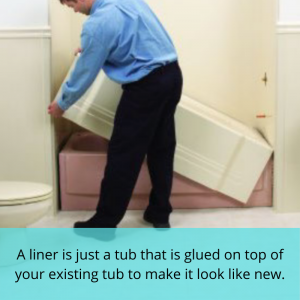
We’ve all seen the plastic tub kiosks in the mall, housing expos, and just about everywhere…but what are tub and shower liners? According to Wikipedia, “Bathtub liners also known as tub liners, acrylic tub liners and tub inserts are made by vacuum forming an acrylic or PVC (poly vinyl chloride) sheet which is heated then formed in a mold by applying vacuum. Having the proper mold is important for the tub liner to fit properly. Typically a bathtub liner will fall between the cost of replacing a bathtub at the high end and bathtub refinishing at the lower end in cost when renovating a damaged or outdated bathtub.” In other words, a tub liner is just another tub that is glued on top of your existing tub to make it look like new. It sounds great in theory, right? Just cover up the problem and POOF! you have the bathroom of your dreams.
….eh not quite.
There are a lot more risks involved with having a tub liner but for some reason this information seems to be swept under the rug. But that’s why we’re here…to give you the good, the bad, and the ugly.
The Good
There are a lot of reasons why someone would opt for a liner, as astutely mentioned on Wikipedia. But let’s list a few real-world reasons why someone would consider a tub liner…
- The low cost when compared to a full remodel.
- The quick timeline when compared to a full remodel.
- Their tub isn’t a viable candidate for resurfacing.
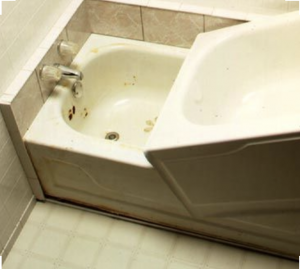
Now let’s unpack that. According to refinishing giant, Miracle Method, “The average acrylic liner installation costs $1,300 and if you add a wall system, soap dishes, etc, the cost can go as high as $4,000!” Which may sound like a lot, but when you consider the national average on bathroom remodels costs about $9,000, it’s peanuts in comparison. So it’s really no mystery why the budget driven home-owner would choose a bathtub liner over replacing it during a full or partial bathroom remodel. And continuing with that, the condensed timeline of a liner install versus that of a bathroom remodel is undoubtably enticing. It’s also important to mention that for a select few, mainly those with structural damage to their tub, are not viable candidates for resurfacing. And in these cases where resurfacing and remodeling are not realistic options then liners become the last resort. But whatever the reason may be, there are undeniably some benefits to having a bathtub liner installed.
The Bad
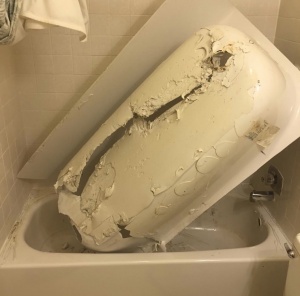
It’s not always happily ever after for those homeowners that opt for a bathtub liner instead of resurfacing or replacing. And unfortunately, for a few unlucky people their tub liner can become their own personal nightmare. But why? Well for starters, in order to adhere the liner to the original tub they have to use a serious cement-like glue that is meant to hold the liner in place forever. Which is great if you never have any issues with your bathtub or shower liner. But if you do, that means once the liner is removed, the original tub underneath will be covered in this disgustingly sticky glue that is nearly impossible to remove, in which case you’ll need to hire a professional to remove it. And once the liner has been disposed of and the orginal tub is exposed it will 10 times out of 10 be in need of resurfacing. Meaning, you could spend thousands of dollars to find out that you hate your bathtub liner and in the end still have to resurface your tub. And this is just another reason why we recommend trying resurfacing before committing to a liner. Or better yet, have your tub casted instead! It’s the best of both worlds when it comes to resurfacing and bathtub liners.
The Ugly
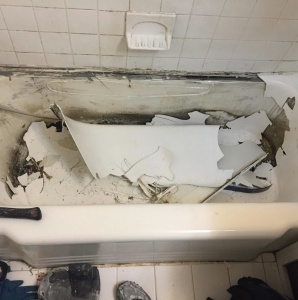
If you thought it couldn’t get any worse then I am sorry to say, buckle up. Standing water, hidden mold, and squeaky tubs OH MY! These are just a few of the horrific realties you could face if your tub liner installation goes awry. In some cases standing water will get in between the liner and original tub. A few things can happen due to this…
- Your liner will start floating, and you’ll feel it when you get in the tub.
- Mold and mildew can form in between the liner and tub, and you won’t be able to see it.
- There could be structural damage to the tub you can’t see. If the bare metal of the original tub was exposed before the liner was installed then the water and the weight of the tub being used can exacerbate any rusting issues causing pitting and/or holes.
And sometimes squeaky tubs have been reported. This happens when the liner does not fit perfectly over the original tub and flexes so they rub against each other, creating the squeak. Not the most attractive feature to have in your bathroom; especially if you paid thousands of dollars for it.
So can you cover an existing bathtub? In the short answer yes, but there’s a lot of pros and cons to weigh when you’re considering a bathroom overhaul. Bathtub and shower liner are a great option…for some people. But it’s ultimately up to you to decide what kind of homeowner you are and what sort of home improvement goals you want to achieve with your hard-earned money.
One response to “The (Ugly) Truth About Tub & Shower Liners”
Leave a Reply
You must be logged in to post a comment.


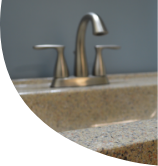
Fantastic!